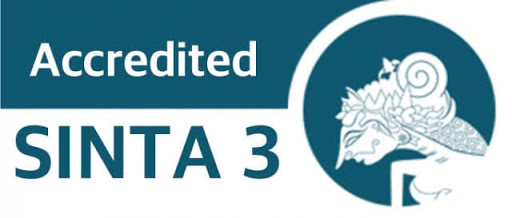THE IMPLEMENTATION OF E-MODULE IN SEMANTIC CLASS AT ENGLISH STUDY PROGRAM: STUDENTS’ PERCEPTION
Abstract
E-module as a learning tool is a new experience for English students. Based on the interviewing results of monitoring and information to students, it is found that the e-module has not been yet implemented or created other than in class 1 Semantic. Therefore, it is important to know how they perceive the implementation of an electronic module in the Semantic class in the English Study Program. The research in this paper aims to investigate English students’ perception of implementing the E-module in Semantic classes at the English Study Program. The research design is mixed methods (quantitative and qualitative). The data were gathered through a questionnaire and interview. Cluster random sampling was used to select the research sample, which involved 40 students. Ten students were interviewed for the qualitative data. The findings indicate that the students had a high perception of the implementation of e-module in the Semantic class. They also expect that e-module can be further developed and applied for other courses because most of them perceive e-module as a fun, complete, and total innovation in learning media that can facilitate their learning anytime and anywhere.
Keywords
Full Text:
PDF (ENGLISH)References
Art R. Napoles, M. (2022). Development and Evaluation of E-Learning Module in 3D
Homes Designing. Journal of Education and Teaching (JET), 3(2), 148–160. https://doi.org/10.51454/jet.v3i2.145
Baranov, A., & Pivovarov, I. (2018). Youtube Video Lectures in Undergraduate Studies. CBU International Conference
Proceedings, 6(2009), 535–539. https://doi.org/10.12955/cbup.v6.1209
Chang, J. C. (2002). Investigating Teachers’ and Students’ Attitude Toward Acceptance of Digital Instructional Materials
with TAM Model. China: Master thesis.
Chong, J. L. S., Yunos, J. M., & Spahat, G. (2005). The Development and Evaluation of an E-module for Pneumatics
Technology. Malaysian Online Journal of Instructional Technology (MOJIT), 2(May 2015), 25–33.
Creswell, J.W., and V.L. Plano Clark. (2011).
Designing and Conducting Mixed Methods Research. Thousand Oaks: Sage Publications.
Darmaji, D., Kurniawan, D. A., Astalini, A., Kurniawan, W., Anwar, K., & Lumbantoruan, A. (2019). Students’ perceptions of
electronic’s module in physics practicum. Journal of Education and Learning (EduLearn), 13(2), 288–294.
https://doi.org/10.11591/edulearn.v13i2.13005
Darmawan, D. 2016. Mobile Learning Sebuah Aplikasi Teknologi Pembelajaran. Jakarta: PT Raja Grafindo Persada.
Daryanto.2013. Menyusun Modul Bahan Ajar Untuk Persiapan Guru Dalam Mengajar.
Dictionary, O. E. (2007). Learner'S Pocket Dictionary 7th ed. Oxford: Oxford University Press.
Hall, R. (2013). Educational technology and the enclosure of academic labour inside public higher education Richard Hall
De Montfort University, England. The Journal for Critical Education Policy Studies, 52–82.
Huberman, A., & Miles, M., (1994). Qualitative data analysis (2nd ed.). Thousand Oaks, CA: Sage Publications
Laili, I. (2019). Efektivitas Pengembangan E-Modul Project Based Learning Pada Mata Pelajaran Instalasi. Jurnal Imiah
Pendidikan Dan Pembelajaran, 3, 306–315. https://ejournal.undiksha.ac.id/index.php/JIPP/article/download/21840/13513
Metcalfe, J., & Mischel, W. (1999). A hot/cool-system analysis of delay of gratification: Dynamics of willpower.
Psychological Review, 106(1). https://doi.org/10.1037/0033-295X.106.1.3
Pradana, R., Sulton, S., & Husna, A. (2020). Pengembangan E-Modul Berbasis Mobile Learning Seni Budaya Materi Konsep
Budaya, Seni, dan Keindahan Untuk Siswa Kelas X SMKN 1 Turen Malang. JINOTEP (Jurnal Inovasi Dan
Teknologi Pembelajaran): Kajian Dan Riset Dalam Teknologi Pembelajaran, 6(2), 89–96.
https://doi.org/10.17977/um031v6i22020p089
Purwanti, I. T., Suryawati, E., & Eliwarti. (2022). Video Lectures in Online EFL Flipped-Classroom: Effectiveness,
Students’ Evaluation and Experiences. European Journal of Educational Research, 11(2), 885–898.
https://doi.org/10.12973/EU-JER.11.2.885
Purwanto, Rahadi, A., & Lasmono, S. (2007). Pengembangan Modul. Jakarta: Pusat Teknologi Informasi dan Komunikasi
Pendidikan Departemen Pendidikan Nasional.
Ricu Sidiq, & Najuah. (2020). Pengembangan E-Modul Interaktif Berbasis Android pada Mata Kuliah Strategi Belajar Mengajar.
Jurnal Pendidikan Sejarah, 9(1), 1–14. https://doi.org/10.21009/jps.091.01
Robbins, S. P. (2007). perilaku organisasi Buku 1. Jakarta: Salemba Empat.
Robbins, S. P. (2010). Organizational Behavior. New Jersey: Prentice- Hall.
Schleicher, A. (2018). The Future of Education and Skills Eduction 2030. OECD.
Sirwan, Kamal, & Nurkhamid. (2021). Developing E-module based on mobile learning as a preparation media. Journal of
Physics: Conference Series, 1833(1). https://doi.org/10.1088/1742-6596/1833/1/012049
Slameto. (2010). Belajar dan Faktor-Faktor Yang Mempengaruhinya. Jakarta: Rineka Cipta.
Syamsudin. (2005). Psikologi Pendidikan dan Perkembangan. Yogyakarta: Rineka Cipta 2.
Teng, S. M., Cheng, S. S., Chen, B.-I., & Liu, E. Z. (2013). Perceptions of satisfaction, usefulness, and ease-of-use in
the use of health education website. International Journal of Education And Information Technologies, 7(4).
Vitoria, L., Mislinawati, M., & Nurmasyitah, N. (2018). Students’ perceptions on the implementation of e-learning: Helpful
or unhelpful? Journal of Physics: Conference Series, 1088. https://doi.org/10.1088/1742-6596/1088/1/012058
Watoni, E. S., Ngabekti, S., & Wijayati, N. (2022). Development of Lombok Island Environmental Change E-Module to Improve
Environmental Literacy and Data Literacy of High School Students. Journal of Innovative Science Education, 11(2), 160–174.
https://journal.unnes.ac.id/sju/index.php/jise/article/view/51081%
Ahttps://journal.unnes.ac.id/sju/index.php/jise/article/download/51081/20092
Wiyoko, T., Sarwanto, & Rahardjo, D. T. (2014). Pengembangan Media Pembelajaran Fisika Modul Elektronik Animasi Interaktif
Untuk Kelas XI SMA Ditinjau dari Motivasi Belajar Siswa. Jurnal Pendidikan Fisika Vol.2 No.2 ,11-15.
https://jurnal.fkip.uns.ac.id/index.php/pfisika/article/view/4670
DOI: http://dx.doi.org/10.33578/pjr.v7i2.9054
Refbacks
- There are currently no refbacks.
Copyright (c) 2023 JURNAL PAJAR (Pendidikan dan Pengajaran)

This work is licensed under a Creative Commons Attribution-NonCommercial-ShareAlike 4.0 International License.
JURNAL PAJAR (Pendidikan dan Pengajaran)
Secretariat
Program Studi Pendidikan Guru Sekolah Dasar
Gedung B1, FKIP Universitas Riau
Kampus Bina Widya Km. 12,5 Simpang Baru Panam
Pekanbaru Riau Indonesia 28293
e-mail : pajar@ejournal.unri.ac.id



